Aarticaine hydrochloride
Inquiry
| Post Date: | Nov 18,2017 |
| Expiry Date: | May 17,2018 |
| Detailed Description: |
Cas No. :23964-57-0
Quantity: mass in stockKilograms Specs:white powder Price:negotiable USD Kilograms Payment Method: T/T, Western Union,Moneygram and Bitcoin. Description: Aarticaine HCL is a dental amide type local anesthetic. Aspirin is used to control pain. Like other local anesthetics, arthritis can cause short, completely reversible anesthesia (loss of sensation) during the (dental) procedure. In dentistry, altexine is used both for infiltration and blockage, and the blocking technique produces the greatest duration of anesthesia. Of patients with hypokalemia who are overly stimulated, lidocaine is not very effective, but adeficin is effective. Comparative studies of lidocaine and aldicaine have found that adriptone is more effective in bilocaine in the first molar area after anesthesia in the case of osmotic injection. As with lidocaine, the possibility of successful anesthesia was as high as 3.81 times. However, there is no evidence to support the use of lidocaine for lower alveolar nerve blockers. In addition, despite the successful use of lidocaine for poor dental nerve blockade, it has been shown that aldicaine is superior to the use of supplemental infiltration of persistent pain after lidocaine. Articaine Hydrochloride,Articaine is an intermediate-potency, short-acting amide local anesthetic with a fast metabolism due to an ester group in its structure. It is effective with local infiltration or peripheral nerve block in dentistry, when administered as a spinal, epidural, ocular, or regional nerve block, or when injected intravenously for regional anesthesia. Articaine Hydrochloride, In comparative trials, its clinical effects were not generally significantly different from those of other short-acting local anesthetics like lidocaine, prilocaine, and chloroprocaine, and there is no conclusive evidence demonstrating above-average neurotoxicity. Articaine proved to be suitable and safe for procedures requiring a short duration of action in which a fast onset of anesthesia is desired, eg, dental procedures and ambulatory spinal anesthesia, in normal and in special populations. Applications: Articaine Hydrochloride, Articaine blocks nerve conduction by reversibly binding to the α-subunit of the voltage-gated sodium channels within the inner cavity of the nerve, similar to other local anesthetics. Binding of articaine to the sodium channel reduces sodium influx so that the threshold potential will not be reached and impulse conduction stops. The blocking action of articaine on the sodium channel is state dependent: it has the highest affinity for the open state, an intermediate affinity for the inactivated state, and the lowest affinity for the resting state. Articaine Hydrochloride, The degree of neuronal block is affected by the diameter of the nerve. Larger-diameter fibers (touch/pressure/ motor) require higher concentrations of local anesthetic compared with small myelinated fibers (pain afferents).Articaine is lipid soluble, highly protein-bound (94%), and has a dissociation constant (pKa) of 7.8. Articaine is an intermediate-potency, short-acting local anesthetic with a fast onset of action. |
| CAS Registry Number: | 23964-57-0 |
| Synonyms: | Articaine hydrochloride [USAN];2-Thiophenecarboxylic acid, 4-methyl-3-((1-oxo-2-(propylamino)propyl)amino)-, methyl ester, monohydrochloride;4-Methyl-3-(2-(propylamino)propionamido)-2-thiophenecarboxylic acid methyl ester HCl;Articaine HCl;Articaine hydrochloride;Carticaine hydrochloride;HOE 045;HOE 40045;Methyl 4-methyl-3-(2-(propylamino)propionamido)-2-thiophenecarboxylate, monohydrochloride;Septanest;Septocaine;UNII-QS9014Q792;Ultracain;Ultracaine;2-Thiophenecarboxylic acid, 4-methyl-3-(2-(propylamino)propionamido)-, methyl ester, monohydrochloride;Methyl 4-methyl-3-((1-oxo-2-(propylamino)propyl)amino)-2-thenoate monohydrochloride;methyl 4-methyl-3-[(N-propylalanyl)amino]thiophene-2-carboxylate hydrochloride (1:1); |
| Molecular Formula: | C13H21ClN2O3S |
| Molecular Weight: | 320.8354 |
| Molecular Structure: | 
|
| Company: | Hengyang Desen Science and Technology co., LTD. [ China ] |
| Contact: | Eric yang |
| Tel: | +86-189-08446905 |
| Fax: | |
| Email: | Eric@desen-nutrition.com |
-
Disclaimer statement:The information and data included above have been realized by the enterprises and compiled by the staff, and are subject to change without notice to you. The Chemnet makes no warranties or representations whatsoever regarding the facticity, accuracy and validity of such information and data. In order to ensure your interest, we suggest you chose the products posted by our gold suppliers or VIP members.


